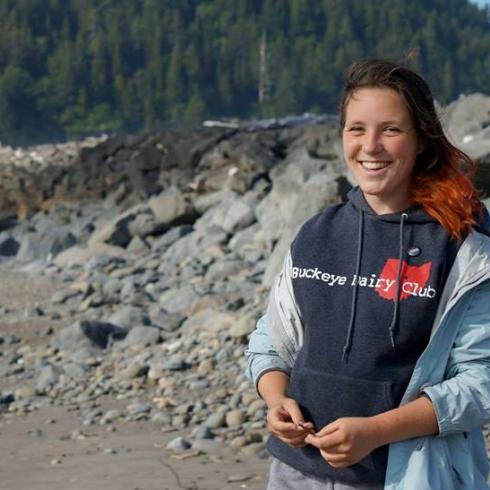After a day of just getting there, we ate our first delicious Tiputini dinner and watched Diego’s presentation about his revolutionary camera trapping program.
The next morning, we split into groups for the week’s activities. First came a hike to La Laguna, the lagoon.

We glided by the tangled banks in a canoe. Our guide José pointed out small fish jumping in a frenzy – piranhas. He may have been joking. Then we heard the barks: CRAAH. CRAAH. CRAAH. CRAAH. Heavy bustling in the overhanging shrubs. Something big was in there, and it wanted to eat us! The raspy caws echoed from all sides. Then, these guys popped out of the bushes onto the top branches to check us out. Meet the hoatzins.

These birds are considered prehistoric because they’ve evolved so little over time. They have claws on the insides of their wings, making them seem like the closest link to archaeopteryx, but really we have no idea what they’re related to. When startled, the chicks drop from the nest into the water and use their claws to climb back up. Their diet is almost entirely tree leaves, and their digestion is like that of a cow. Despite their tendency to pop out of hiding to observe humans, these birds are far from endangered. Luckily for the hoatzin, its meat tastes like manure.

A rendition of my new favorite bird.
In the afternoon we were assigned Puentes y Torre: the bridges and tower. If you even remotely know me, you know how I felt about this activity. Here are a few examples of what happens when I get more than 10 feet off the ground:



However, I had known this moment would arrive, and I’d been preparing myself mentally for weeks. There was no way I was going to let a fear of heights stop me from perhaps the only chance I would ever get to walk on Amazonian canopy bridges.



I’ve been on a couple high-ropes-courses before, maybe 40 feet off the ground maximum, but nothing comes close to these bridges. I plugged my ears when our guide Mayer told us how tall they were, so I still don’t know. I would guess about 100 feet. As with the ropes courses, I made myself a goal: to complete every bridge and become calm enough on the platforms to look for birds. But when we got to the second platform, I drew a line.

This ladder leaned over open air to climb an additional 20 feet into the canopy. The safety ropes were explained vaguely in Spanish, and our first trooper, Lauren, started to climb. I was shaking and sobbing in a chair, recovering from the first bridge, and decided the ladder did not fall within my goals. I did, however, complete all four bridges, and I even took these bird photos from the last platform. Mission accomplished.



The descent back down the blue scaffold staircase was worse than the ascent, but reaching terra firma was the best. I was just starting to compose myself on the hike back to camp when we suddenly came to another blue scaffold tower, this one twice as tall. Not having realized the “Torre” part of “Puentes y Torre” was still to come, I was caught completely off guard and began to sob. This was too much. Our kind guide told me I could stay on the ground, but this tower was within my goal and I was definitely going to climb it.
But first, we distracted ourselves by climbing this incredible strangler fig!

Competition is so fierce in the tropics that plant species will do anything they can to get by: epiphytes perch on branches to steal sunlight, pioneer species grow quickly with giant leaves but die young due to insect susceptibility, old-growth species tolerate the shade while they build up dense wood and pest immunity. But no plant’s strategy is more sinister than the strangler fig’s. This plant begins life as an epiphyte but quickly drops long, sinuous roots to the forest floor. Once firmly attached, the fig begins to wrap around the trunk and literally strangle its host. Eventually the fig will become so powerful that the host tree dies, leaving the hollow skeleton of a killer (like the one we climbed.) This is a typical example of parasitism – but look at it from a tree’s time scale, and it becomes a case of violent tree-on-tree predation!
Then the dreadful hour struck and we had to begin climbing the Tower of Doom. But really, it wasn’t so bad.
There were a few tears of terror, sure, but you can’t fear death too much when you’re surrounded by as much beauty as you are in the Amazon.

That night, we decided to tempt the Grim Reaper one more time. We went caiman hunting.
And then we went to bed. It’s amazing how sometimes, I feel like I saw more in a day than I have in my whole life.

Nina Finley
<p><span style="color: rgb(29, 29, 29); font-family: Arial, Verdana, sans-serif; font-size: 12px; line-height: normal; background-color: rgb(237, 237, 237);">Nina Finley is a sophomore at The Ohio State University. She ventured to the Midwest from her hometown of Seattle, Washington to major in Animal Sciences and Evolution & Ecology. She would like to become a livestock vet or marine biologist. When she’s not studying, Nina loves to play ultimate frisbee, watch birds and raise meat rabbits. She’s passionate about agriculture, nature and Spanish, all of which she hopes to explore in Ecuador. Join the journey as Nina traces Darwin’s path and explores the natural wonders of the Galapagos Islands!</span></p>







